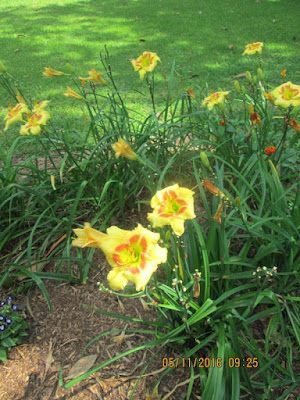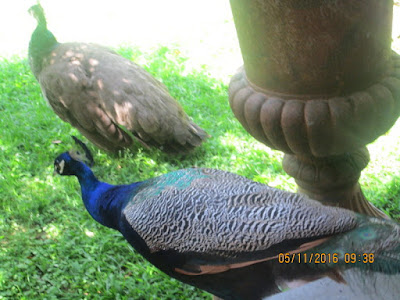Jamie and Linda are the best tour guides!
This plantation is midway between Baton Rouge and New Orleans on the historic River Road.
We came here for lunch and a tour of the gardens and it took a huge chunk of the day. We saw only the gardens. To see the inside of the house as well would have required a second day--and we were running out of time.
Houmas House is known as the Crown Jewel of River Road.
The first owners of the plantation were the indigenous Houmas Indians who were given a land grant to occupy the fertile ground.
The Houmas sold the land to Maurice Conway and Alexander Latin in the mid 1700's.
We were never out of sight of a fountain.
The original French Provincial house that Latil erected on the property is situated directly behind the mansion and adjoined by a carriageway to the grand home. It was known during the antebellum heyday as "The Sugar Palace".
The original home was later used as living quarters for the staff that served the great house.
"Walk this way..."
I always thought these were 'guardhouses' built at the entrance to the estate. However, I learned, these tiny two story houses were for the young, single men to sleep in after a wild night of carousing. When the revelers arrived back at the plantation they would be so noisy they would wake the others. This was where they were billeted until they 'slept it off'.
By the time of the Louisiana Purchase in 1803, the plantation was established and producing sugar.
In 1810 Gen. Wade Hampton purchased the property and began construction on the mansion. It was completed in 1828 by Caroline and Col John Preston.
This is the pet cemetery....
...and the markers are so sweet.
(Sigh Me's marker is a cactus. Not quite so elegant as these)
While the house was being built, land holdings increased for the production of sugar cane. The plantation ultimately grew to 300,000 acres.
An Irishman, a shrewd businessman, and a real character, John Burnside bought the plantation in 1857 for $1,000,000. He increased sugar production until Houmas House was the largest producer in the country. During the Civil War, Burnside saved the Mansion from destruction at the hands of advancing Union forces by declaring immunity as a subject of the British Crown.
Burnside, a bachelor, is also said to have offered payment to any parents in the parish who would name their sons, 'John.'
John was an avid sportsman who wagered heavily in horse races. He once secretly purchased a champion thoroughbred back East with the intent of defeating the steeds of fellow local businessmen in a big race. He quietly slipped the racehorse into the billiard room of the Mansion. There it was stabled until Burnside's surprise was unveiled at the starting line and ultimately hailed in the winner's circle.
I don't know if Burnside was responsible for this little guy with the fish tail but....
...the poor thing is forever condemned to support the weight of this oak branch.
Following Burnside came another military man, Col. William Miles who grew the plantation to its apex in the late 1800's. Houmas House was producing a monumental 20 million pounds of sugar each year!
It was time for us to stop for lunch...
We never seem to get very far without a scrumptious meal and this place was amazing.
There were interesting chandeliers in the restaurant, and...
Even a Civil War submarine!
Then back outside for more fountains.
In 1927, the Mississippi came out of its banks in the epic 'great flood.' Houmas house was spared but the surrounding areas were inundated. The record devastation was then followed by the 'Great Depression' just two years later.
"Eventually, the Crozat heirs opened the property to tourists. In 1963, the defining Bette Davis film, "Hush, Hush Sweet Charlotte" was shot on the property."
SNAKE!
Thanks, Guys. It was great.
(Yes, I am still in Minnesota for a few more days and there is still another posting to do on New Orleans. I am trying to get caught up but all the sightseeing just keeps getting in the way.)
The Italic writings are from the Houmas House website.




































Your posts are so much fun, that place is amazing indeed. The opulence must have been such astark contrast to the lives of the servants/slaves who kept these places going. In researching my southern roots recently, I counted the names of 17 "servants" associated with my ancestor. A bit unsettling to yours truly!
ReplyDeleteAnne, Thank you for the nice comment. I know what you mean about our shared southern history. How sad that we cannot be proud of our 'land owning ancestors' when we learn that their comforts were based largely on the discomforts of others. May we not forget that.
ReplyDelete